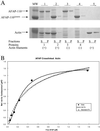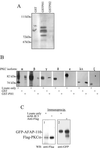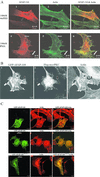PC phosphorylation increases the ability of AFAP-110 to cross-link actin filaments
- PMID: 12134071
- PMCID: PMC117315
- DOI: 10.1091/mbc.e01-12-0148
PC phosphorylation increases the ability of AFAP-110 to cross-link actin filaments
Abstract
The actin filament-associated protein and Src-binding partner, AFAP-110, is an adaptor protein that links signaling molecules to actin filaments. AFAP-110 binds actin filaments directly and multimerizes through a leucine zipper motif. Cellular signals downstream of Src(527F) can regulate multimerization. Here, we determined recombinant AFAP-110 (rAFAP-110)-bound actin filaments cooperatively, through a lateral association. We demonstrate rAFAP-110 has the capability to cross-link actin filaments, and this ability is dependent on the integrity of the carboxy terminal actin binding domain. Deletion of the leucine zipper motif or PKC phosphorylation affected AFAP-110's conformation, which correlated with changes in multimerization and increased the capability of rAFAP-110 to cross-link actin filaments. AFAP-110 is both a substrate and binding partner of PKC. On PKC activation, stress filament organization is lost, motility structures form, and AFAP-110 colocalizes strongly with motility structures. Expression of a deletion mutant of AFAP-110 that is unable to bind PKC blocked the effect of PMA on actin filaments. We hypothesize that upon PKC activation, AFAP-110 can be cooperatively recruited to newly forming actin filaments, like those that exist in cell motility structures, and that PKC phosphorylation effects a conformational change that may enable AFAP-110 to promote actin filament cross-linking at the cell membrane.
Figures








Similar articles
-
The actin filament-associated protein AFAP-110 is an adaptor protein that modulates changes in actin filament integrity.Oncogene. 2001 Oct 1;20(44):6435-47. doi: 10.1038/sj.onc.1204784. Oncogene. 2001. PMID: 11607843 Review.
-
The carboxy terminus of AFAP-110 modulates direct interactions with actin filaments and regulates its ability to alter actin filament integrity and induce lamellipodia formation.Exp Cell Res. 2000 Feb 25;255(1):102-13. doi: 10.1006/excr.1999.4795. Exp Cell Res. 2000. PMID: 10666339
-
Src can regulate carboxy terminal interactions with AFAP-110, which influence self-association, cell localization and actin filament integrity.Oncogene. 1998 Apr 30;16(17):2185-95. doi: 10.1038/sj.onc.1201753. Oncogene. 1998. PMID: 9619827
-
Analysis of the role of the leucine zipper motif in regulating the ability of AFAP-110 to alter actin filament integrity.J Cell Biochem. 2004 Feb 15;91(3):602-20. doi: 10.1002/jcb.10725. J Cell Biochem. 2004. PMID: 14755689
-
Calmodulin and protein kinase C cross-talk: the MARCKS protein is an actin filament and plasma membrane cross-linking protein regulated by protein kinase C phosphorylation and by calmodulin.Ciba Found Symp. 1992;164:145-54; discussion 154-61. doi: 10.1002/9780470514207.ch10. Ciba Found Symp. 1992. PMID: 1395931 Review.
Cited by
-
AFAP1 Is a Novel Downstream Mediator of TGF-β1 for CCN2 Induction in Osteoblasts.PLoS One. 2015 Sep 4;10(9):e0136712. doi: 10.1371/journal.pone.0136712. eCollection 2015. PLoS One. 2015. PMID: 26340021 Free PMC article.
-
A Polymorphic Variant of AFAP-110 Enhances cSrc Activity.Transl Oncol. 2010 Aug 1;3(4):276-85. doi: 10.1593/tlo.10106. Transl Oncol. 2010. PMID: 20689769 Free PMC article.
-
There is more than one way to model an elephant. Experiment-driven modeling of the actin cytoskeleton.Biophys J. 2013 Feb 5;104(3):520-32. doi: 10.1016/j.bpj.2012.12.044. Biophys J. 2013. PMID: 23442903 Free PMC article. Review.
-
The actin-binding domain of actin filament-associated protein (AFAP) is involved in the regulation of cytoskeletal structure.Cell Mol Life Sci. 2012 Apr;69(7):1137-51. doi: 10.1007/s00018-011-0812-5. Epub 2011 Oct 8. Cell Mol Life Sci. 2012. PMID: 21984596 Free PMC article.
-
Myosin heavy-chain kinase A from Dictyostelium possesses a novel actin-binding domain that cross-links actin filaments.Biochem J. 2006 Apr 15;395(2):373-83. doi: 10.1042/BJ20051376. Biochem J. 2006. PMID: 16372899 Free PMC article.
References
-
- Baisden JM, Qian Y, Zot HG, Flynn DC. The actin filament associated protein, AFAP-110, is an adaptor protein that modulates changes in actin filament integrity. Oncogene. 2001a;20:6435–6447. - PubMed
-
- Baisden JM, Gatesman AS, Cherezova L, Jiang BH, Flynn DC. The intrinsic ability of AFAP-110 to alter actin filament integrity is linked with its ability to also activate cellular tyrosine kinases. Oncogene. 2001b;20:6607–6616. - PubMed
-
- Blikstad I, Markey F, Carlsson L, Persson T, Lindberg U. Selective assay of monomeric and filamentous actin in cell extracts using inhibition of deoxyribonuclease I. Cell. 1978;55:935–943. - PubMed
-
- Bourguignon LY, Zhu H, Shao L, Chen YW. CD44 interaction with c-Src kinase promotes cortactin-mediated cytoskeleton function and hyaluronic acid (HA)-dependent ovarian tumor cell migration. J Biol Chem. 2001;276:7327–7336. - PubMed
-
- Boyle WJ, van der Geer P, Hunter T. Phosphopeptide mapping and phosphoamino acid analysis by two-dimensional separation on thin-layer cellulose plates. Methods Enzymol. 1991;201:110–149. - PubMed
Publication types
MeSH terms
Substances
Grants and funding
LinkOut - more resources
Full Text Sources
Molecular Biology Databases
Miscellaneous

